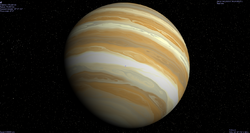Astronomy:47 Ursae Majoris d
From HandWiki
Short description: Extrasolar planet in the constellation Ursa Major
 An artist's impression of 47 UMa d | |
| Discovery | |
|---|---|
| Discovered by | Gregory and Fischer |
| Discovery site | |
| Discovery date | 6 March 2010 |
| Doppler spectroscopy (Bayesian Kepler periodogram) | |
| Orbital characteristics | |
| 11.6+2.1−2.9[1] AU | |
| Eccentricity | 0.16+0.09−0.16[1] |
| Orbital period | 14,002+4018−5095[1] d ~38.33 y |
| astron|astron|helion}} | 2,451,736+6783−5051[1] |
| 110+132−160[1] | |
| Star | 47 Ursae Majoris |
47 Ursae Majoris d (sometimes abbreviated 47 Uma d) is an extrasolar planet approximately 46 light-years away in the constellation of Ursa Major. The planet was discovered located in a long-period orbit (38 years) around the star 47 Ursae Majoris. As of 2011, it is the outermost of three known planets in its planetary system. It has a mass of at least 1.64 times that of Jupiter. It is the longest-period planet detected by Doppler spectroscopy. The evidence of this planet was found by Bayesian Kepler periodogram in March 2010.[1]
References
- ↑ 1.0 1.1 1.2 1.3 1.4 1.5 Gregory, Philip C.; Fischer, Debra A. (2010). "A Bayesian periodogram finds evidence for three planets in 47 Ursae Majoris". Monthly Notices of the Royal Astronomical Society 403 (2): 731–747. doi:10.1111/j.1365-2966.2009.16233.x. Bibcode: 2010MNRAS.403..731G. https://academic.oup.com/mnras/article/403/2/731/1181806.
- Jean Schneider (2011). "Notes for Planet 47 Uma d". Extrasolar Planets Encyclopaedia. https://exoplanet.eu/catalog/47_uma_d--648/.
Coordinates: ![]() 10h 59m 28.0s, +40° 25′ 49″
10h 59m 28.0s, +40° 25′ 49″
 |


